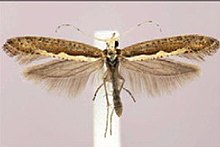Plutella xylostella
| Diamondback moth | |
|---|---|
 |
|
 |
|
| Scientific classification | |
| Kingdom: | Animalia |
| Phylum: | Arthropoda |
| Class: | Insecta |
| Order: | Lepidoptera |
| Family: | Plutellidae |
| Genus: | Plutella |
| Species: | P. xylostella |
| Binomial name | |
|
Plutella xylostella (Linnaeus, 1758) |
|
| Synonyms | |
|
|
The diamondback moth (Plutella xylostella), sometimes called cabbage moth, is a European moth believed to originate in the Mediterranean region that has since spread worldwide. The moth has a short lifecycle (14 days at 25 °C), is highly fecund, and is capable of migrating long distances. It is one of the most important pests of cruciferous crops in the world and usually only feeds on plants that produce glucosinolates. However, not all of these plants are equally useful as hosts to the moth; a 2006 academic paper suggested using wintercress as a trap crop around agricultural fields, as diamondback moths are highly attracted to that plant but their larvae fail to survive when eggs are laid on it.
The diamondback moth has a global distribution and is found in Europe, Asia, Africa, the Americas, Australia, New Zealand, and the Hawaiian Islands. It probably originated in Europe and was first observed in North America in 1854, in Illinois. It had spread to Florida and the Rocky Mountains by 1883, and was reported from British Columbia by 1905.
The diamondback moth has a wingspan of about 15 mm and a body length of 6 mm. The forewings are narrow, brownish-gray and lighter along the anterior margin, with fine, dark speckles. A creamy-coloured stripe with a wavy edge on the posterior margin is sometimes constricted to form one or more light-colored diamond shapes, which is the basis for the common name of this moth. The hindwings are narrow, pointed toward the apex, and light gray, with a wide fringe. The tips of the wings can be seen to turn upward slightly when viewed from the side. The antennae are pronounced. The lifespan averages three to four weeks for females, but rather less for males. These moths are weak fliers, seldom rising more than 2 m above the ground and not flying long distances. They are, however, passive migrants, being easily transferred by wind over long distances. Diamondback moths overwinter as adults among field debris of cruciferous crops, and active adults may be seen during warm periods at any time during the winter in temperate areas. They do not survive cold winters and reinvade colder areas each spring, being carried there by the wind. Moths are active usually at twilight and at night, feeding on flowers of cruciferous plants, but they also fly in the afternoon during mass outbreaks.
The eggs are oval and flattened, measuring 0.44 mm long and 0.26 mm wide. They are yellow or pale green at first, but darken later. They are laid singly or in groups of two to eight eggs in depressions on the surface of leaves. Females may deposit up to 300 eggs in total, but average production is probably half that amount. The larvae emerge from the eggs in about six to seven days.
...
Wikipedia
